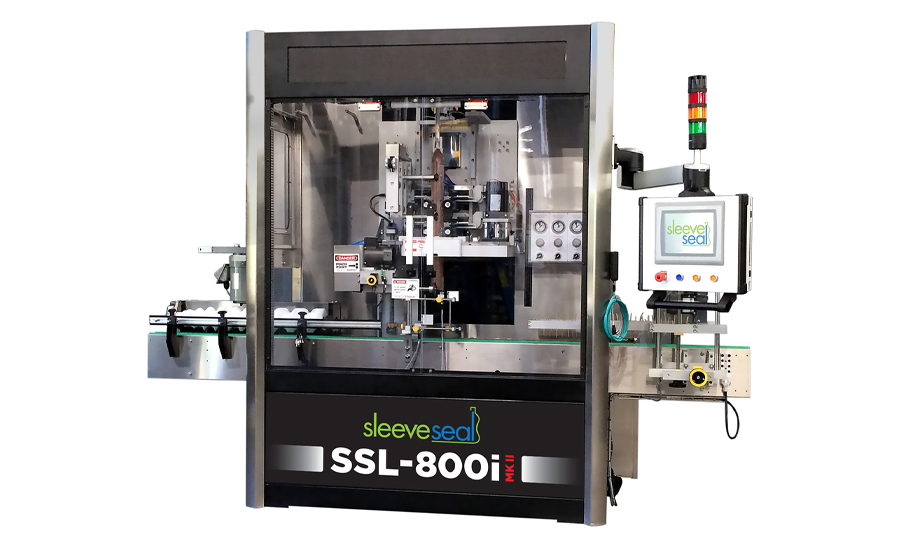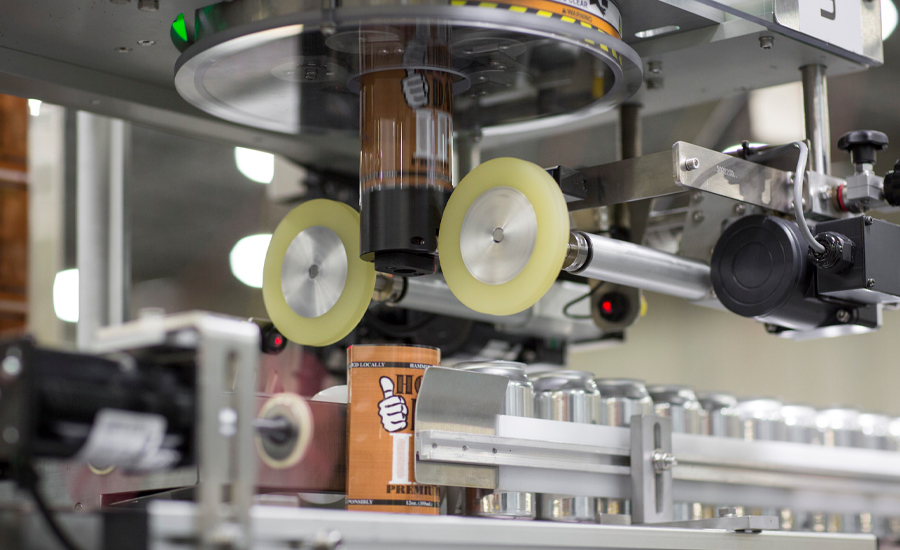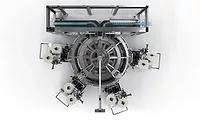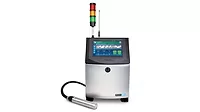Labeling equipment tackles speed, flexibility need states
Thinner label materials, pack sizes evolutions among trends impacting OEMs

PDC offers its KST-55 steam tunnel with an integrated boiler. The KST-55 is a single zone machine with a small footprint, which allows companies to produce a high-quality shrink without a remote boiler, Michael Johnston says.
(Image courtesy of PDC International)
Although the Tokyo 2020 Olympic Games concluded Aug. 8, the iconic event reminded viewers about the versatility and flexibility that these athletes possess physically and mentally. In the beverage market, the diverse need states of consumers is encouraging original equipment manufacturers (OEMs) to ensure that their machines are able to be just as flexible and versatile.
“Labeling materials are always evolving ― thinner, easier to recycle, easier to shrink, etc.,” says Justin Slarks, director of marketing at Sleeve Seal, Little Rock, Ark. “All the changes in materials require changes on the machinery side to accommodate application of new substrates.”
However, evolutions among labeling materials is not the only consumer trend affecting OEMs in the labeling sector.
“Beverage packaging size trends are having a big impact on machinery,” Slarks says. “We produce some ‘XL’ machines for large formats and make changeovers to other formats easy and repeatable on all our machines. Older machines out there are limited in their ability to adapt to market changes, so we are seeing a lot of manufacturers creating new lines with new equipment to manage the changes.”
Michael Johnston, tunnel testing and development technician at PDC International, Norwalk, Conn., notes that the rise in slim cans is another package trend impacting the manufacturing arm.
“The slim seltzer aluminum cans have gained popularity,” he says. “When they are run empty, if not careful they will get blown over by the steam in the shrink tunnel. Our advancements in steam tunnel design helps to reduce the risk of this happening.”
Ryan Cooper, vice president of sales for Raleigh, N.C.-based Axon and Cincinnati-based P.E. Labellers, ProMach product brands, explains that sustainability advancements as well as SKU proliferation have influenced the evolution of labeling equipment.

Image courtesy of Sleeve Seal
“Labelers need to handle a wide range of formats, enabling beverage manufacturers to adapt to customers’ needs as quickly as possible,” he explains. “Customers going from bottles to cans, as well as those looking into thinner materials (both container and film) to reduce plastic consumption, must keep in mind production speeds as well as container sizes, shapes, and strength to prevent bottlenecks.”
Striking a balance
With a larger set of SKUs coupled with increased demand for functional beverages as well as convenient package formats, beverage-makers are exhibiting a desire for labelers that can operate at faster speeds, Cooper explains. But there are limits to this application.
“In can sleeving, the style or shape of the container can affect how fast the sleever can apply sleeves,” he says. “This makes slim and sleek sleeving a more challenging application that requires expertise to run at speeds faster than 150 [cans per minute] (cpm).
“On the other hand, roll-fed customers looking to run at faster speeds are exploring alternatives to hot glue in hopes of reducing downtime and higher [overall equipment efficiency] (OEE),” Cooper continues. “Pre-glued labels are a sustainable option that’s gaining traction in the U.S. Often, customers are looking for a machine that can run both pre-glued and hot glue labels and flexibility becomes the deciding factor.”
Sleeve Seal’s Slarks notes that the company’s customers have one of two bottom lines: speed and adaptability to handle multiple formats.
“We have customers out there running 13 or more formats at lower speeds and other customers running a single product 750 [cans per minute] (cpm), two shifts a day, six days a week ― both with 99.5% plus efficiencies.”
Slarks notes that the company’s portfolio features smart machines that can accommodate these need states.
“Sleeve Seal offers a range of machines from slow to very fast with our automated intelligence onboard,” he says. “All our machines are engineered to be easy to operate and easy to make changeovers.”
In addition to speed, beverage-makers are needing labeling equipment to handle diverse runs. PDC’s Johnston notes that mico-breweries have been active with this operations practice.

Image courtesy of ProMach
“In the past few years, we have seen an upsurge in micro-breweries making small runs of a wide array of flavors,” he says. “In order to keep printing costs down they have turned to shrink sleeves for their needs. Shrink sleeves allow the manufactures to produce eye-catching graphics without housing large amounts of costly printed aluminum cans, while giving them the ability to change the look of the product often.”
Johnston adds that versatility, space savings and ease of operations have driven customer requests.
“In recent years we have seen a heightened interest in increased line speeds, greater application accuracy, and shrink of the highest quality,” he says. “One of our latest inventions here at PDC is our KST-55 steam tunnel with an integrated boiler. The KST-55 is a single zone, easy to operate, versatile machine with a small footprint, allowing start-ups to produce a high-quality shrink without an expensive remote boiler.”
Axon and P.E. Labellers’ Cooper notes the brands have incorporated these key attributes into its machines.
“Both Axon and P.E. Labellers have extensive product lines with technologies designed to meet a wide range of applications,” he says. “On the P.E. side, we can incorporate all our technologies on one machine to give customers maximum flexibility.
“Likewise, Axon offers machinery capable of handling a great variety of shaped containers, film thicknesses and varying production speeds,” Cooper continues. “Our Aurora shrink sleeve applicator is a popular choice for customers because it allows them to perform one or all five key shrink applications, including full body, partial and full body over-the-cap sleeves, multipacks and twin packs, and tamper evident bands.”
Planning for tomorrow
Although it can be easy for beverage manufacturers to seek out equipment for today’s needs, Sleeve Seal’s Slarks encourages beverage manufacturers to not only think about their current operating capacity, but what it could be down the road.
“Beverage-makers should consider machines that can adapt and grow with production,” he says. “It is sometimes tough for us to get across to potential customers, but it always better to have machines that are running below their capacity rather than having machines that are at their limit every day.”
Beyond capacity considerations, Slarks says the beverage market could see a rise in textured inks, which could impact existing labeling equipment.
“There is one trend that will be interesting to watch develop and will require advanced labelers to apply ― this is the textural, raised ink that we are seeing in some of our newer projects,” he says. “These labels ‘feel’ different in the consumers’ hands and creates a very high-end experience of the product. This type of printing produces labels that are inherently much thicker than normal labels so it will be interesting to see what demands this puts on other remanufacturer’s equipment.”
Meanwhile, Axon and P.E. Labellers’ Cooper notes that advancements with roll-fed applications is fueling improvements to labeling machines.
“In roll-fed, a single, multifunction drum and revolutionary cutting system in a cartridge,” he says. “Our most recent development, Simpl-Cut, is revolutionizing roll-fed labeling because it solves the two major challenges with traditional roll-fed labelers: excess hot-melt adhesive build-up on the cutting drum that requires constant cleaning and the utilization of complex cutting blades that are difficult to change.
“Our bottled water and soft drink customers have seen significant improvements in OEE,” Cooper continues. “They have reduced the frequency of cleaning the labeler from two to three times per shift to once per day, and they can now change cutting blades in under two minutes. Moreover, they can now run both pre-glued and hot glue labels on the same machine.”
With beverage-makers growing their portfolios and evolving their packaging materials and sizes, OEMs look equipped to support these changes.
Looking for a reprint of this article?
From high-res PDFs to custom plaques, order your copy today!





